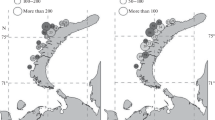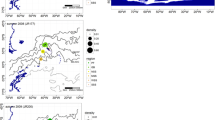Abstract
Dogielinotus loquax Barnard, a common intertidal macroinvertebrate on exposed ocean beaches near Grays Harbor, Washington, USA, is distributed from mid to mean high tidal levels, with a mean density of 1 830 m-2 in 1975–1976. Location of maximum density within the intertidal zone is related to surf intensity and varies seasonally. The species is iteroparous and has an average sex ratio of 1:1. Temperature constraints on growth and egg development rates apparently influence the timing of reproduction. Two dominant recruitments occur per year, one in early spring (the summer generation) and another in late summer (the overwintering generation). The sampling design and density estimates permitted estimation of the mortality rate for the summer generation. Shorebird predation is suspected to affect summer generation abundance.
Similar content being viewed by others
Literature Cited
Bosworth, W. S.: Three new species of Eohaustorius (Amphipoda, Haustoriidae) from the Oregon coast. Crustaceana 25, 253–260 (1973)
Bousfield, E. L.: Adaptive radiation in sand-burrowing amphipods. Chesapeake Sci. 11, 143–154 (1970)
Bousfield, E. L.: Shallow-water gammaridean amphipoda of New England, 312 pp. Ithaca, New York: Comstock Pub. Associates 1973
Bousfield, E. L.: Talitroidean amphipod crustaceans from the North American Pacific coast: systematics and distributional ecology. XIV Pacific Science Congress Comm. F. Abstract, 78 (1979)
Bousfield, E. L.: Evolution in North Pacific coastal marine amphipod crustaceans. In: Evolution today, Second Int. Congr. Syst. Evol. Biol. Proceedings, pp 68–89. Ed. by J. L. Reveal and G. G. E. Scudder 1981
Bousfield, E. L. and Tzvetkova: Studies on Dogielinotidae Amphipoda: Gammaridea) of the North Pacific region. Issled. Fauni Merei: Akad. Nauk. SSSR (In press)
Cassie, R. M.: Some uses of probability paper in the analysis of size frequency distributions. Aust. J. mar. freshwat. Res. 5, 513–522 (1954)
Cochran, W. G.: Sampling techniques, 413 pp. New York: Wiley and Sons 1963
Cooper, W. E.: Dynamics and production of a natural population of a fresh-water amphipod Hyalella azteca. Ecol. Monogr. 43, 377–395 (1965)
Dahl, E.: Some aspects of the ecology and zonation of the fauna on sandy beaches. Oikos 4, 1–27 (1952)
DeMarch, B. G. E.: The effects of photoperiod and temperature on the introduction and termination of reproductive resting stage in the freshwater amphipod Hyalella azteca (Saussure). Can. J. Zool. 55, 1595–1600 (1977)
Dexter, D. M.: Life history of the sandy-beach amphipod Neohaustorius schmitzi: (Crustacea: Haustoriidae). Mar. Biol. 8, 232–237 (1971)
Gabrielson, I. N. and S. G. Jewett: Birds of the Pacific Northwest, 650 pp. New York: Dover Publications 1970
Goss-Custard, J. D.: The winter feeding ecology of the redshank, Tringa totanus. Ibis 111, 330–356 (1969)
Goss-Custard, J. D.: The energetics of prey selection by redshank, Tringa totanus (L.), in relation to prey density. J. Anim. Ecol. 46, 1–19 (1977a)
Goss-Custard, J. D.: Predator responses and prey mortality in redshank, Tringa totanus (L.), and a preferred prey, Corophium volutator (Pallas). J. Anim. Ecol. 46, 21–35 (1977b)
Hall, D. J.: An experimental approach to the dynamics of a natural population of Daphnia galatea mendotae. Ecology 45, 94–112 (1964)
Hall, H. M.: A gathering of shorebirds, 242 pp. New York: Devin-Adair 1960
Harding, J. P.: The use of probability paper for the graphical analysis of polymodal frequency distributions. J. mar. biol. Ass. U.K. 28, 141–153 (1949)
Hughes, J. E.: The population dynamics of an intertidal sandybeach amphipod from the Washington coast, 168 pp. M.S. thesis, Seattle: University of Washington 1978
Hynes, H. B. N. and F. Harper: The life histories of Gammarus lacustris and G. pseudolimnaeus in southern Ontario. Crustaceana Suppl. 3, 329–341 (1972)
Jansson, B.-O.: Diurnal and annual variation of temperature and salinity of interstitial water in sandy beaches. Ophelia 4, 173–201 (1967)
Lewin, J.: Blooms of surf-zone diatoms along the coast of the Olympic Peninsula, Washington. IX. Factors controlling the nitrate in the surf at Copalis Beach (1971 through 1975). Estuar. cstl mar. Sci. 7, 173–183 (1978)
Lewin, J., T. Hruby and D. Mackas: Blooms of surf-zone diatoms along the coast of the Olympic Peninsula, Washington. V. Environmental conditions associated with the blooms (1971 and 1972). Estuar. cstl mar. Sci. 3, 229–241 (1975)
Mills, E. L.: The biology of an ampeliscid amphipod crustacean sibling species pair. J. Fish. Res. Bd Can. 24, 305–355 (1967)
Naylor, E.: Rhythmic behavior and reproduction in marine animals. In: Adaptation to environment: essays on the physiology of marine animals, pp 393–429. Ed. by R. C. Newell. Boston: Butterworths 1976
Quenouille, M. H.: The design and analysis of experiment, 356 pp. London: Chas. Griffin 1953
Sameoto, D. D.: Comparative ecology, life histories, and behavior of intertidal sand-burrowing amphipods (Crustacea: Haustoriidae) at Cape Cod. J. Fish. Res. Bd Can. 26, 361–388 (1969)
Seber, G. A. F.: The estimation of animal abundance, 506 pp. New York: Hafner Press 1973
Sheader, M.: Distribution and reproductive biology of Corophium insidiosum (Amphipoda) on the north-east coast of England. J. mar. biol. Ass. U.K. 58, 585–596 (1978)
Steele, D. H. and V. J. Steele: The biology of Gammarus (Crustacea, Amphipoda) in the Northwestern Atlantic. VII. The duration of embryonic development in five species at various temperatures. Can. J. Zool. 51, 995–999 (1973)
Steele, V. J., D. H. Steele and B. R. MacPherson: The effect of photoperiod on the reproductive cycle of Gammarus setosus Dementieva, 1931. Crustaceana Suppl. 4, 58–63 (1977)
Tate, M. W. and R. C. Clelland: Nonparametric and shortcut statistics, 171 pp. Danville, Illinois: Interstate Printers and Publishers 1957
Teissier, G.: Relative growth. In: The physiology of crustacea. Vol. 1. Metabolism and growth, pp 537–560. Ed. by T. H. Waterman. New York: Academic Press 1960
Van Dolah, R. F., L. E. Shapiro and C. P. Rees: Analysis of an intertidal population of the amphipod Gammarus palustris using a modified version of the egg-ratio method. Mar. Biol. 33, 323–330 (1975)
Winberg, G. G.: Methods for the estimation of production of aquatic animals, 175 pp. New York: Academic Press 1971
Author information
Authors and Affiliations
Additional information
Communicated by S. K. Pierce, College Park
Dogielinotus loquax will soon be elevated to the type of a new genus, Proboscinotus (Bousfield and Tzvetkova, in press)
Contribution no. 1271 from the Department of Oceanography, University of Washington; Seattle, Washington 98195, USA
Rights and permissions
About this article
Cite this article
Hughes, J.E. Life history of the sandy-beach amphipod Dogielinotus loquax (Crustacea: Dogielinotidae) from the outer coast of Washington, USA. Mar. Biol. 71, 167–175 (1982). https://doi.org/10.1007/BF00394626
Accepted:
Issue Date:
DOI: https://doi.org/10.1007/BF00394626




